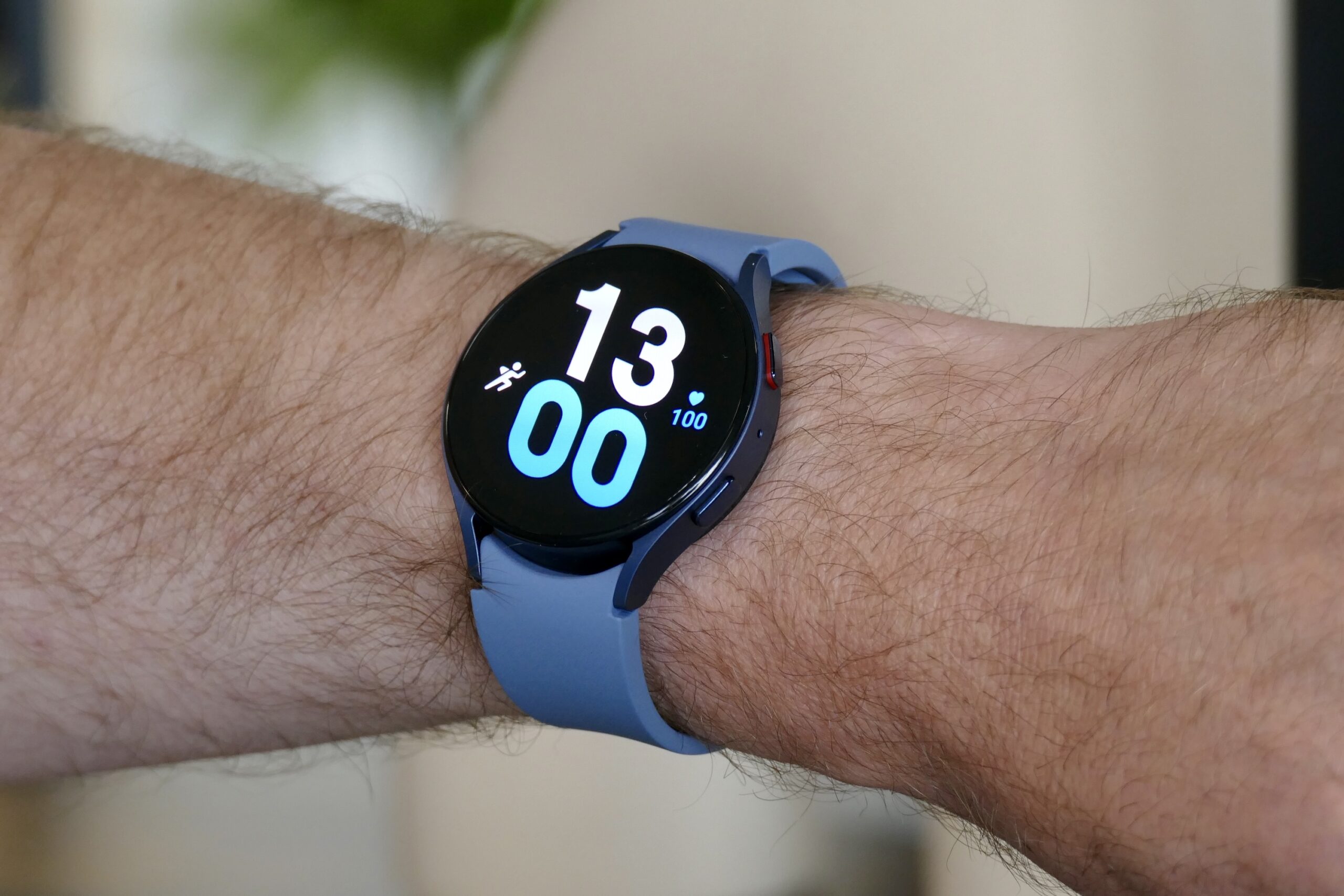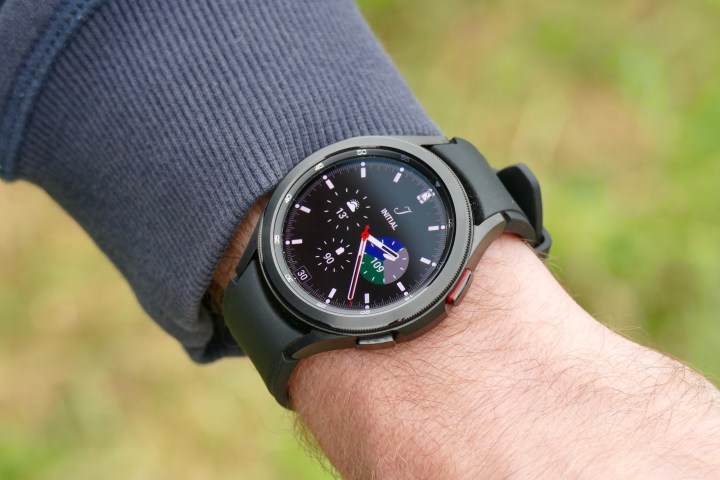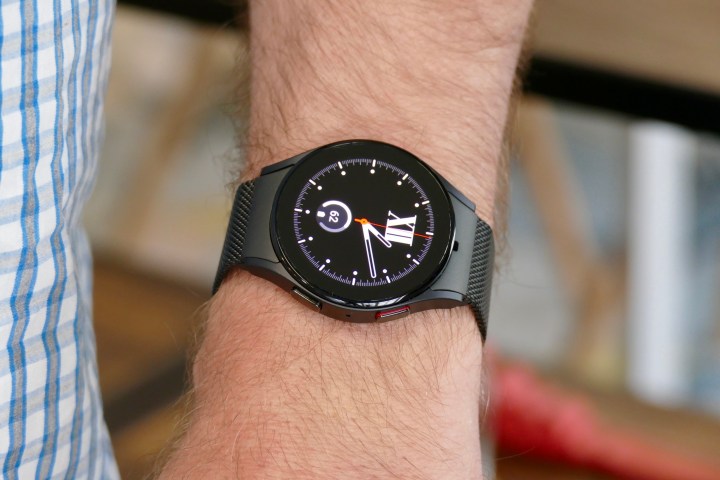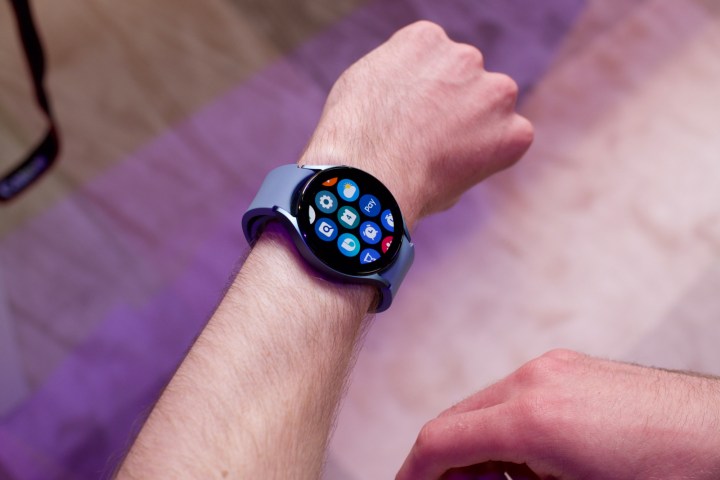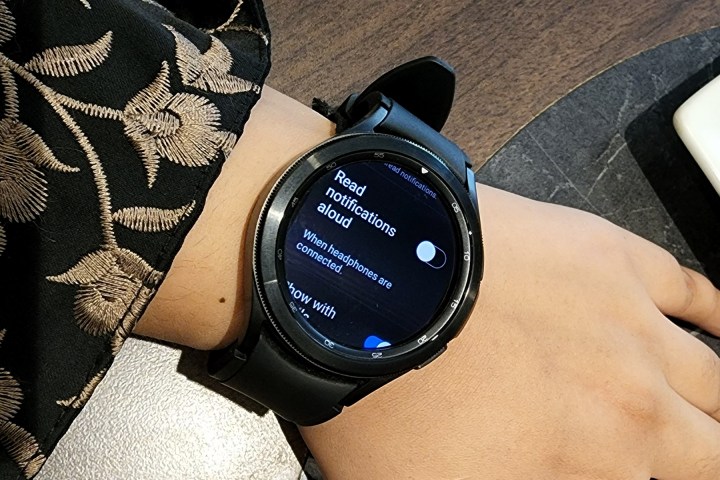The Samsung Galaxy Watch 5 series is here, and if you’re in the market for a new Galaxy Watch, you might find yourself wondering if it’s worth shelling out for Samsung’s latest addition, or whether you should stick with the Galaxy Watch 4. differences between the two might not be immediately obvious, so we’ve done the leg work and compared the Samsung Galaxy Watch 5 vs. Galaxy Watch 4 across several categories to help you decide which one is the best buy for you.
Specs
| Samsung Galaxy Watch 5 |
Samsung Galaxy Watch 4 | |
| display size | 40mm: 1.2 inches
44mm: 1.4 inches SapphireCrystal |
40mm: 1.2 inches
44mm: 1.4 inches |
| body size | 40mm: 40.4 x 39.3 x 9.8mm (1.59 x 1.55 x 0.39 inches)
44mm: 44.4 x 43.3 x 9.8mm (1.75 x 1.70 x 0.39 inches) |
40mm: 40.4 x 39.3 x 9.8mm (1.59 x 1.55 x 0.39 inches)
44mm: 44.4 x 43.3 x 9.8mm (1.75 x 1.70 x 0.39 inches) |
| Weight | 40mm: 28.7 grams
44mm: 33.5 grams |
40mm: 25.9 grams
44mm: 30.3 grams |
| Resolution |
40mm: 396×396 44mm: 450×450 |
40mm: 396 x 396 pixels (330 pixels per inch)
44mm: 450 x 450 pixels (330 ppi) |
| touch screen | 40mm: 1.2-inch AMOLED touchscreen
44mm: 1.4-inch AMOLED touchscreen |
40mm: 1.2-inch Super AMOLED touchscreen
44mm: 1.4-inch Super AMOLED touchscreen |
| Storage | 16 GB | 16 GB |
| wireless-interface | Bluetooth 5.2, Wi-Fi 802.11 a/b/g/n 2.4+5GHz, NFC, LTE (select models), GPS/GLONASS/Beidou/Galileo | Bluetooth 5.0, Wi-Fi 802.11 a/b/g/n, NFC, LTE (select models), GPS/GLONASS/Beidou/Galileo |
| Depth | 9.8mm | 9.8mm |
| Accelerometer | And it is | And it is |
| gyroscope | And it is | And it is |
| Ambient light sensor | And it is | And it is |
| heart rate sensor | And it is | And it is |
| Barometer | And it is | And it is |
| gps | And it is | And it is |
| water resistance | Yes (5ATM + IP68) | Yes (5ATM + IP68) |
| Battery life | 40mm: 284mAh
44mm: 410mAh Up to 50 hours (based on Samsung laboratory measurements) WPC-based wireless charging |
40mm: 247mAh
44mm: 361mAh Up to 40 hours (based on Samsung laboratory measurements) WPC-based wireless charging |
| Price | From $280 | From $200 |
| Availability | Samsung | Samsung, Amazon, Best Buy |
| DT review | hands-on | 4 out of 5 stars |
Design and display
- 1.
Galaxy Watch 4 - two.
Galaxy Watch 5
When it comes to design, Samsung has opted for repetition over reinvention here. Both watches look pretty similar and share virtually identical physical characteristics. Neither has a rotating bezel — you’ll need to grab the Watch 4 Classic if that’s your preference — but the digital alternative provides a contemporary, streamlined look.
The Watch 5 sports a modern, minimalist design and comes in two sizes, 40mm or 44mm, weighing 28.7 and 33.5 grams, respectively. The Watch 4 comes in the same sizes, again weighing in at 25.9 grams and 30.3 grams, respectively. There’s no difference between dimensions here, but the Watch 4 is ever so slightly lighter, if that’s important to you.
Whichever watch you go for, there’s a 1.2-inch or 1.4-inch Super AMOLED display on board, with the same resolution of 396 x 396 or 450 x 450 across the board too, depending on which size you choose. Everything looks sharp and clear. Samsung claims the Watch 5’s sapphire crystal lens provides a 60% harder outer layer than the Watch 4 series, but both watches have the same durable Armor Aluminum body.
The Galaxy Watch 5 40mm comes in Graphite, Pink Gold, or Silver with a Bora Purple strap designed to perfectly match the Galaxy Z Flip 4. The 44mm variant comes in Graphite, Sapphire, or Silver. You can pick up the Galaxy Watch 4 in Silver, Black, or Pink Gold with a choice of bands.
As you can see, the differences here are fairly minimal, so it may not be worth paying more for the Watch 5 if you’re considering upgrading — unless the new colors and sapphire crystal lens tempt you to trade in. As such, we’re calling this round a tie.
Winner: tie
Fitness and health-tracking features
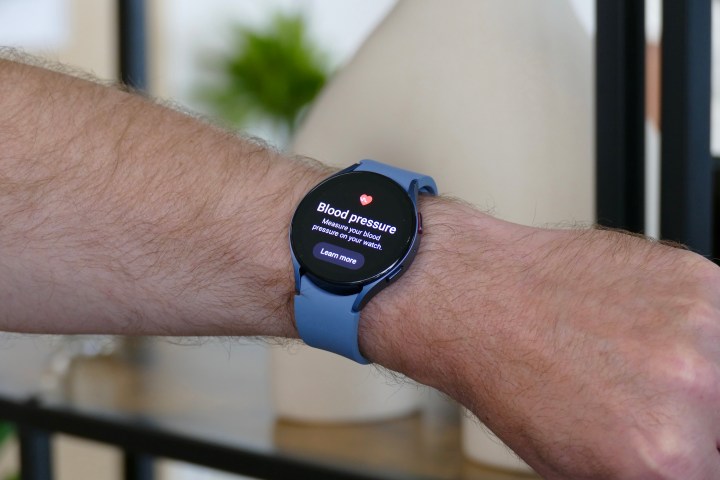
There are some subtle differences between these two devices when it comes to fitness tracking. Both feature Samsung’s BioActive Sensor, but the Watch 5 has an enlarged surface area to improve the accuracy of readings. The sensor includes a Bio-Electrical Impedance (BIA) sensor, electrocardiogram (ECG), and PPG heart rate sensor so you can monitor sleep, body fat levels, blood-oxygen level, and blood pressure (the latter is only available in some countries , however).
The Watch 5 has a few new features, including GPX, available for the first time on a Galaxy Watch, so you can download or display routes as well as record new routes and share them with friends. There is also turn-by-turn directions to help keep cyclists and runners on track, and the new trackback feature, which takes you back the way you came, great for long walks or hikes. While you’ll find these features on most Garmin and other multisport watches, they’re not usually included on flagship smartwatches, so this is a pretty neat addition. These new features ensure the Watch 5 is an excellent choice for runners, hikers, and long-distance walkers.
The main new feature on the Watch 5 is the temperature sensor, which uses infrared technology for accurate temperature monitoring, even if the temperature of your surroundings changes. This could be used for period tracking or as an early sickness indicator, but Samsung plans to work with developers to explore new ways to use this in the “near future,” so we could be waiting a while before there’s actually a use for it.
Both watches also offer advanced sleep tracking that monitors sleep stages, snore detection, and body oxygen levels. On the Watch 5, you also get Sleep Coaching, a tailored month-long guided program designed to help improve your sleep habits.
Both the Watch 4 and Watch 5 can track over 100 different workouts with automatic workout detection, plus the familiar digital running coach and VO2 max data, which lets you know how much oxygen you’re using during your training and is a good indicator of aerobics. fitness.
So which watch wins this round? We’re giving it to the Galaxy Watch 5, but it’s a close one as most of the health and fitness tracking features on the new Watch 5 can also be found on the Watch 4. The added GPX features, that new temperature sensor, and improved sleep tracking just push the Watch 5 into the lead here.
Winner: Samsung Galaxy Watch 5
Battery life
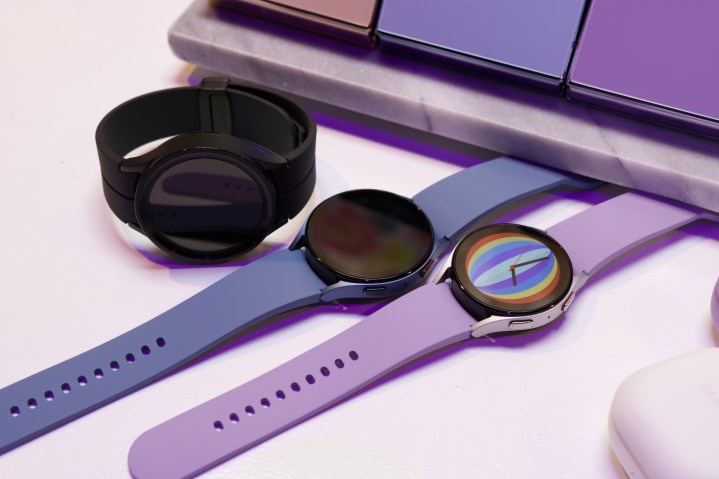
Battery life is one of the key differences between these two watches. The 40mm variant of the Galaxy Watch 5 packs a 284mAh battery, compared to the 247mAh battery powering the 40mm Galaxy Watch 4. Meanwhile, the 44mm is powered by a 410mAh battery, compared to the 361mAh battery on offer in the 44mm Galaxy Watch 4. Samsung promises a battery life of up to 50 hours with the Watch 5 and 40 hours with the Watch 4, though this will depend on your usage.
Faster charging is on offer with the Galaxy Watch 5 too, with Samsung claiming you can top up from zero to 45% in just 30 minutes. If you use your watch for sleep tracking, you might be interested to know Samsung also says that eight minutes of charging will give you eight hours of battery life, so there’s no need to worry about your watch dying halfway through your sleep cycle.
There’s a clear winner here, and it’s the Watch 5 with its beefier battery and faster charging. This could change once we’ve spent more time with Samsung’s latest, though, so watch this space.
Winner: Samsung Galaxy Watch 5
special features
- 1.
Galaxy Watch 5 - two.
Galaxy Watch 4
Neither watch has a rotating bezel, so if that’s a must-have for you, the Watch 4 Classic is the watch you’re looking for.
In terms of special features, both watches offer comprehensive sleep tracking, but the Watch 5 adds sleep coaching that tailors a guided program based on your sleep tracking metrics to help improve the quality of your sleep. Both watches also work with compatible smart devices and the Samsung SmartThings app to control lights, TVs, and air conditioners to improve your sleeping environment. With the Watch 5, you’re also getting that infrared temperature sensor, though it may be a while before we start to see compatible apps.
Both watches run WearOS 3 and Samsung’s One UI Watch. The Watch 5 ships with One UI Watch 4.5, with new accessibility features, an improved typing interface, and dual-SIM support. With Wear OS 3 you get access to Google Assistant from your watch, and features coming soon include being able to use voice navigation in Google Maps, plus music apps like Deezer and SoundCloud.
You’ll also find the same IP68 and 5ATM water (and dust) resistance ratings across both the Watch 4 and Watch 5.
There’s not enough here to differentiate between the two watches, as both pack similar special features, so ultimately, whether or not you want to spend more for an infrared temperature sensor and sleep coaching may be the deciding factor here.
Winner: tie
Price and availability
The Galaxy Watch 5 is available to until August 25. Pricing starts at $280 for the 40mm Bluetooth version and $330 for the 40mm LTE variant. Pre-orders also get a free Wireless Charger Duo, $75 off when you trade in an eligible smartwatch, and $50 of Samsung credit to spend on accessories. The Galaxy Watch 5 retail sales open August 26.
The Galaxy Watch 4 is from Samsung, Amazon, Best Buy, and other major retailers. Pricing starts from $200 for the 40mm Bluetooth variant and $250 for the 40mm LTE version.
Overall winner: Samsung Galaxy Watch 5
We’re crowning the Galaxy Watch 5 our overall winner, though we’d like to point out this was a very close run. Both watches are so similar across the board in terms of design, specs, and fitness tracking features that, for most people, the incremental upgrades simply aren’t enough to warrant the extra $80-plus cost of Samsung’s latest wearable. That said, if you’re buying your first Samsung Galaxy Watch, we’d wholeheartedly recommend the Watch 5. If you’re considering upgrading from the Galaxy Watch 4, there’s not a lot new here unless you’re into long-distance walking or hiking and need those GPX features, simply must have a bigger battery and faster charging, or you really want an infrared temperature sensor on your wrist.
Editors’ Recommendations
